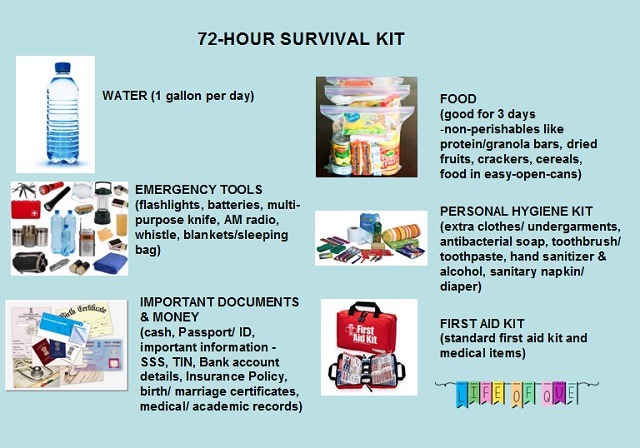The Philippines, due to its location along the Ring of Fire, or typhoon belt, is prone to natural disasters like typhoons, earthquakes, and volcanic eruptions. It is believed that the first 72 hours after a disaster is critical that is why each of us should be prepared to be self-reliant and able to survive for at least three days following a disaster.
Here’s a list of items we need to prepare before disaster strikes. The list is based on the Red Cross Lifeline Kit.
1. WATER (1 GALLON PER DAY)
One can survive without food for 5 days but not without water. Prepare clean water in clean airtight containers for washing, drinking and cooking
1 gallon (3.78 L) per person per day [1L for drinking and 3L for washing]
1 Water purification tablet per person per day. 1 tablet can purify a liter of water
2. FOOD (GOOD FOR 3 DAYS)
Store non-perishable food like protein/granola bars, dried fruits such as raisins, crackers, cereals, easy to prepare food in easy-open-cans
In case of hypoglycemia, canned juice or hard sweet candies are recommended
Disposable plates and utensils
3. EMERGENCY TOOLS / GEAR
Emergency numbers to call (Red Cross, Fire/Police station, Hospital, Family)
Whistle that is loud and if possible one that has a compass on it.
Flashlight with extra batteries. Self-powered flashlight is recommended.
Multi-purpose knife – Waterproof matches or lighter and candles
AM radio with extra batteries or self-powered for monitoring the news, weather condition and any possible threats
Glow sticks
Plastic sheeting or garbage bag
Emergency or Heating blankets / Sleeping bag
Ropes (Nylon is not recommended)
4. PERSONAL EFFECTS AND HYGIENE KIT
Extra Clothing and undergarments
Antibacterial soap
Toothbrush/ Toothpaste
Hand towels (super absorbent)
Comb/ hair brush
Hand sanitizer and alcohol
Sanitary napkin / Diaper
5. IMPORTANT DOCUMENTS AND MONEY
Cash or loose change in a plastic envelope/ zip lock
List of important information (SSS number, TIN, driver’s license, Passport Number, Bank account details, Insurance policy, etc.)
Passport
Important legal documents like Birth certificates, marriage contract, insurance certificates, and land titles
Other important documents: academic credentials, vaccination records, medical records, etc
These items should be placed in a zip locks or waterproof bags if you have one.
6. SPECIAL NEEDS (Of elderly, children, infant or sick member of the family)
Emergency medication (Acetaminophen, Ibuprofen, anti- diarrhea, for cough and colds, children’s medication, etc.)
Prescription Medication (for 3 days, like anti hypertensive, insulin, etc.)
Children’s food
7. FIRST AID KIT (Standard)
First Aid Kit items:
1 Adhesive Strips (Pk50)
1 Hypo – Allergenic medical tape 1.25cm x 9.1m
1 Conforming Bandage 5cm
1 Triangular Bandage 110cm x 110cm
1 Wound Dressing No. 15
2 Swabs Antiseptic
1 Tweezers metal 8cm
1 Scissors disposable
1 Safety pin – assorted (pk12)
1 Plastic Bag – resealable – 100 X 180 mm
1 Plastic Bag – resealable – 150 x 230 mm
2 Gloves – disposable
1 First Aid Quick Reference Guide
As advised by Red Cross, it is also important to prepare a kit for each member of your family who is able to carry one. Older children can prepare their own kits so as the exercise will train them to make disaster preparedness a way of life.
When packing food, water and medicine in the into the kits, it is advised to keep track of the expiration date. Water should be replaced every 6 months. For those with kids, pack small toys, books or materials that can provide some entertainment during stressful times.
I’m guilty as we do not have this in place and I know it is very important to be prepared for an emergency. This is quite an overwhelming list but I plan to start on with the documents as they are the easiest one to prepare as of now.
How about you, do you have an emergency kit prepared for the family?
Keep safe everyone and let’s be disaster ready all the time.






8 comments